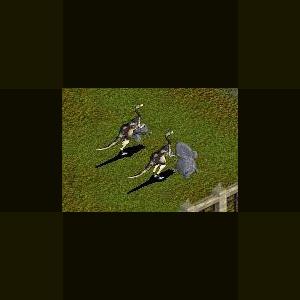About This File
Avimimus was a small dinosaur, standing about 45 centimeters (2.5 ft) tall at the hips and
a length of 1.5 m (5 ft). The skull was relatively small compared to the body, though the
brain and eyes were relatively large. The size of the bones which surrounded the brain and
were dedicated to protecting it are large. This is also consistent with the hypothesis
that Avimimus had a proportionally large brain.
As in the related Oviraptoridae and Caenagnathidae, the jaws of Avimimus formed a
parrot-like beak, and lacked teeth. However, a series of toothlike projections along the
tip of the premaxilla would have given the beak a serrated edge. The toothless beak of
Avimimus suggests that it may have been an herbivore or omnivore. Kurzanov himself,
however, believed that Avimimus was an insectivore.
The foramen magnum, the hole allowing the spinal cord to connect with the brain, was
proportionally large in Avimimus. The occipital condyle, however, was small, further
suggestive of the skull's relative lightness.The neck itself was long and slender, and is
composed of vertebrae are much more elongate than in other oviraptorosaurs. Unlike
oviraptorids and caenagnathids, the back vertebrae lack openings for air sacs, suggesting
that Avimimus is more primitive than these animals.
The forelimbs were relatively short. The bones of the hand were fused together, as in
modern birds, and a ridge on the ulna (lower arm bone) was interpreted as an attachment
point for feathers by Kurzanov.Kurzanov, in 1987, also reported the presence of quill
knobs, and while Chiappe confirmed the presence of bumps on the ulna, their function
remained unclear. Kurzanov was so convinced they were attachment points for feathers that
he concluded that Avimimus may have been capable of weak flight. This interpretation has
not seen wide support among paleontologists, however.
The ilium was almost horizontally oriented, resulting in exceptionally broad hips. Little
is known of the tail but the hip suggests that the tail was long. The legs were extremely
long and slender, suggesting that Avimimus was a highly specialized runner. The
proportions of the leg bones add further weight to the idea of Avimimus was quick on its
feet. The animal's shins were long in comparison with its thighs, a trait common among
cursorial animals. It also had three-toed feet with narrow pointed claws.
Its remains were discovered in the Djadokta Formation by Russian paleontologists, and
officially described by Dr. Sergei Kurzanov in 1981. The type species is A. portentosus.
Because no tail was found with the original find, Dr. Kurzanov mistakenly concluded that
Avimimus lacked a tail in life. However, subsequent Avimimus finds containing caudal
vertebrae have confirmed the presence of a tail.
In 1991, Sankar Chatterjee erected the Order Avimimiformes to include Avimimus, though
this group is not used by most paleontologists today as it includes only a single species.



Recommended Comments
Create an account or sign in to comment
You need to be a member in order to leave a comment
Create an account
Sign up for a new account in our community. It's easy!
Register a new accountSign in
Already have an account? Sign in here.
Sign In Now